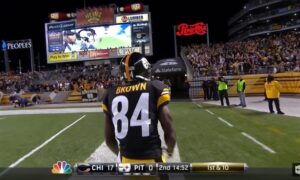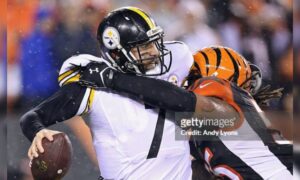Even with one quarterback already in the Hall of Fame (two if you count the five years that Bobby Layne spent with the team at the end of his career) and another destined to wind up there when his playing career is over, nobody would argue the claim that the Pittsburgh Steelers were built on the back of a strong running game.
Though Franco Harris and Jerome Bettis are on the tip of the tongue as the running backs that have steered the ship of this franchise, many other names could be spoken in this regard as contributors on that journey, from Dick Hoak, Rocky Bleier, and John Henry Johnson, to Merril Hoge, Bam Morris, and Willie Parker.
The Steelers have been a historically great franchise rushing the ball over the decades, but this truth has been less evident in recent years. Just this past season, the team ranked 27th in the league in total rushing yards.
Things have not been much the same since the last great offensive line fell apart with the departures of the likes of Alan Faneca and Jeff Hartings, but the Steelers are determined to return to their old ways with Le’Veon Bell, LeGarrette Blount, and Mike Munchak’s new offensive line, beginning this season.
Even Ben Roethlisberger has over the years become a proponent of maintaining a balanced offense and claims to be on board with the efforts to reestablish a strong running game behind their new bell cow running back.
The truth of the matter is, however, that Roethlisberger could well be one of the greatest beneficiaries of an improved running game, and in a way that is very directly correlated to his own on-field performance.
More specifically, with the ease with which defenses have been able to defend the Steelers’ rushing attack of late, the play-action passing game has not been very effective as a diversionary tactic, and accordingly, Roethlisberger has not been able to utilize it often, nor to great effect, in recent years.
A season ago, Roethlisberger dropped back to pass 639 times. He ran play action on just 74 of those drop backs, a league low at less than 12 percent of the time. His 74 drop backs resulted in four sacks and two scrambles in addition to 68 pass attempts.
Roethlisberger completed 42 passes for 570 yards on play action, netting three touchdowns, but he also threw four interceptions.
His interception percentage of 5.9 was the worst in the league, and his touchdown percentage was also below average. For comparison, his interception percentage without play action was under two.
Even his completion percentage, with 34 drops, was nearly four points higher without play action a season ago. His actual accuracy was nearly seven points higher, when accounting for dropped passes.
The impact of the running game of late simply has not been enough to justify the play action pass as a viable weapon for the offense. Defenses need to respect and fear a rushing attack in order to over-commit and bite on the play action, particularly with a quarterback who’s not a threat to run just because he can.
In other words, Roethlisberger should be just as on board with the team’s attempts to reestablish the ground game as anybody, as he appears to be, because it will only make his job easier.







